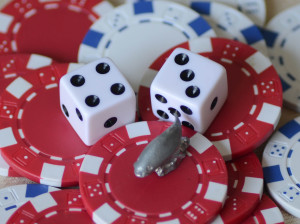From Wikipedia...”Probability is a measure or estimation of how likely it is that something will happen or that a statement is true. Probabilities are given a value between 0 (0% chance or will not happen) and 1 (100% chance or will happen). The higher the degree of probability, the more likely the event is to happen, or, in a longer series of samples, the greater the number of times such event is expected to happen”.
Maximizing one’s probability of success in fishing is really a large part of what this game is about. Success can mean different things to different people and will depend greatly on their goals for that day. Goals may include catching the most fish, the biggest fish, a certain species of fish, catching fish with a certain technique, or even just having a relaxing day.
 In fishing there will also always be a certain chance or luck factor involved. When I was young on a vacation with my family I happened across a small pond no larger than 1/3 of an acre in size. Thinking it may be a good spot to fish I cast in with a bobber, sinker and hook with a small piece of bread attached. I had used this technique with good success to catch many minnows and creek chub on a creek at my home and thought that a similar fate would befall me here. What I didn’t suspect was a 30 inch northern pike would smash this offering and be towed to shore. Even more unlikely is that when I ran out of bread I attached a small piece of a Styrofoam cup to my hook, somehow tempting another northern to pounce and succumb to the wobbly fishing skills of a 12 year old.
In fishing there will also always be a certain chance or luck factor involved. When I was young on a vacation with my family I happened across a small pond no larger than 1/3 of an acre in size. Thinking it may be a good spot to fish I cast in with a bobber, sinker and hook with a small piece of bread attached. I had used this technique with good success to catch many minnows and creek chub on a creek at my home and thought that a similar fate would befall me here. What I didn’t suspect was a 30 inch northern pike would smash this offering and be towed to shore. Even more unlikely is that when I ran out of bread I attached a small piece of a Styrofoam cup to my hook, somehow tempting another northern to pounce and succumb to the wobbly fishing skills of a 12 year old.
Now as well as that worked that day if you asked me what would give me the best chances to catch northern pike I would not say “in a tiny pond with bread or Styrofoam on a small hook…”.
There are a variety of factors that will affect the probability of catching fish on a given day. Some are under our control such as type of bait, fishing location, speed of bait retrieval etc. Some are not, including the weather, water clarity, water temperature and so on. All things being considered, if the independent probability of each factor contributing to the success of catching fish is moderate or good than the chance of catching fish will be moderate or good for that day. However, if even just one variable is low, or worse, extremely low, than the chance of catching fish will be low to extremely low.
Why is this?
Probability, with independent variables (a reasonable assumption for most fishing parameters), is calculated as a multiple of fractions based on the chance of an event occurring. For example, for a single cast of the line on a specific day there could be a 1 in 4 chance that a fish is present in the spot you cast, a 1 in 5 chance that it is hungry for the bait you have thrown, a 1 in 2 chance that it sees it in the clear water, and a 1 in 3 chance that it will successfully be hooked and landed.
Thus the overall probability (P) of success on that cast will then be:
P = 1/4 X 1/5 X 1/2 X 1/3
= 1/120
Or 1 chance in 120 casts… no too bad. Perhaps if we change lures to trusty “ole faithful”, you know the one that always works for you. Now we have a 1 in 2 chance that the fish will strike.
P = 1/4 X 1/2 X 1/2 X 1/3
= 1/48
Or 1 in 48 casts… much better. But what if the water clarity is truly horrible, such as in a “blown out” river after a heavy rain, and we’re after a fish that relies mostly on sight feeding. Now that one parameter drops to say 1 in 50.
P = 1/4 X 1/2 x 1/50 x 1/3
= 1/1200
Or 1 in 1200 casts… even with “ole faithful” on the line its going to be a long day.
This illustrates nicely how one parameter can limit our success so greatly. If it is one that is out of our control (such as the “blown out” river example above) it may be time to move on or reschedule our trip. If parameters outside of our control are fine, then one should always be working on optimizing controllable parameters such as lure choice, presentation technique, line type, hook sharpness, et cetera to maximize success.


